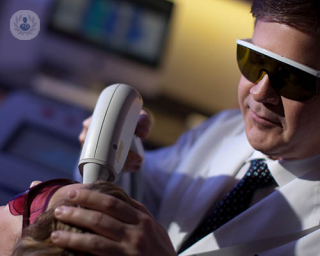Vascular laser treatment
Dr Jibu Varghese - Dermatology
Created on: 11-13-2012
Updated on: 04-04-2023
Edited by: Sophie Kennedy
What is vascular laser treatment?
Vascular laser treatment (or thermocoagulation or photosclerosis) is a fast and effective method for eliminating vascular lesions on any area of the body or face. Vascular lesions include varicose veins, telangiectasias, couperose and rosacea, port wine stains, haemangiomas and angiomas, Poikiloderma of Civatte and cherry angioma.
The treatment eliminates red lesions quickly, safely and comfortably and does not interrupt the person’s social or work life. It corrects the blood vessels that caused the vascular lesion without damaging the surrounding tissues.

Why is it performed?
Vascular laser treatment is recommended for anyone with red vascular lesions on any area of the body, especially on the legs, where they can cause more discomfort. However, it is also suitable for facial lesions, such as facial telangiectasias, facial erythema, cherry angioma and venous lakes, amongst others.
What does it involve?
Vascular laser treatment consists of applying a laser or pulse of light that penetrates the skin and transforms into heat as it is absorbed by the haemoglobin from the damaged blood vessels. This heat coagulates the vessels and facilitates their elimination. This technique, known as selective photothermolysis, gradually reduces the size of vascular lesions and, consequently, the associated pain (especially in the legs), without affecting the rest of the skin.
During treatment, the specialist will cover your eyes with protective goggles. The laser will be then be applied to the lesions, so you may feel a slight burning sensation. At the end of the treatment you may notice some redness in the treated area.
The treatment consists of several sessions of around forty-five minutes each and you can resume your normal activity afterwards. In some cases, however, a dressing may be necessary and you may be advised to rest. If the treatment is performed on the face, biomasks and creams are usually applied to make it more comfortable for you.
The number of sessions required will vary for each patient, depending on the number and size of the vessels affected, as well as on the degree of vascular reactivity. The treatment is usually carried out over one or two months and the results are visible around ten days after the first session, as the lesions gradually become smaller.
How should you prepare for vascular laser treatment?
No special preparation is necessary for vascular laser treatment, but it is important that the skin is not burned, as the laser used applies heat to the skin.
Post-treatment care
The specialist will normally recommend using an anti-inflammatory cream to reduce pain or discomfort after vascular laser treatment. Some people also need to wear compression stockings after treatment on the legs. The most important thing is to avoid sun exposure and very warm places that would increase the body temperature significantly.




